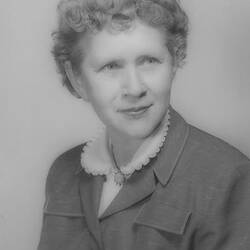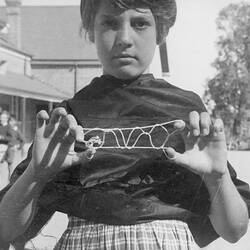Summary
Alternative Name(s): Knucklebone Jacks, Astragali, Astragalus, Talus
A gift to Dorothy Howard from Miss Kelly, Melbourne, 1954. She dug them up in her garden (buried there by her dog).
Knucklebones, or Jacks, is an ancient game, dating back to prehistoric times. The first jacks were natural materials - animal bones, stones, seeds and shells. Sheep's knucklebones were the most common type of jacks in Australia during the first half of this century, and children would colour them by boiling them in water with ink or dye. During the 1950s, mass-produced plastic knucklebones became available.
These knucklebones are representative of the playing pieces used in ancient times, and by Roman soldiers as a gambling device. Sheep's knucklebones are used to play Jacks in many countries, and in Australia before World War II, they were the most common type of jacks available.
This set is part of the Dorothy Howard Collection, gathered by eminent US folklorist and scholar Dr Dorothy Howard, who visited Australia as a Fulbright fellow in 1954-55 to document and research the folklore of Australian children. The Collection primarily contains documents, photographs and objects from Australia and the United States. It is now contained with the Australian Children's Folklore Collection (ACFC), unique in Australia, documenting contemporary children's folklore across Australia and in other countries reaching back to the 1870s. The Collection has a strong component of research material relating to Victoria.
Physical Description
Five sheep knucklebones in a square cardboard box with lid. Four of the bones are of similar size, one is smaller and very weathered. The box has a white base, the lid is white with grey and red stripes around the sides and printed in grey on the top. There are two round green stickers - one inside the box and one on the side of the lid.
More Information
-
Collection Names
Australian Children's Folklore Collection, Dorothy Howard Collection
-
Collecting Areas
-
Acquisition Information
Cultural Gifts Donation from Dr June Factor, 18 May 1999
-
Acknowledgement
Donated through the Australian Government's Cultural Gifts Program.
-
Other Association (See Comments)
Dr Dorothy Howard, Victoria, Australia, pre 1954
Given to Dr Howard, who in turn gave them to June Factor, the donor. -
Inscriptions
On lid: Knucklebones, 24
-
Classification
-
Category
-
Discipline
-
Type of item
-
overall dimensions
8 cm (Length), 8 cm (Width), 3 cm (Height)
-
References
See Supp File 99.01.
-
Keywords
Children's Folklore, Children's Play, Farm Animals, Food Technology, Games, Livestock, Sheep, Making History - Australian Childrens Folklore

